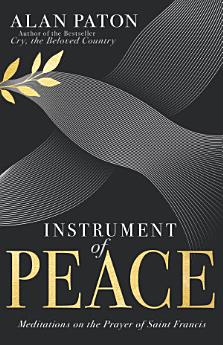Instrument of Peace: Meditations on the Prayer of Saint Francis
About this ebook
Thus begins the beloved prayer of Saint Francis of Assisi. Although there is some debate over whether the mystic Italian friar actually wrote this poetic prayer, it well expresses his sentiments as a preacher of peace, love, and unity.
Author and freedom-fighter Alan Paton shared those sentiments, drawing upon the Prayer of Saint Francis to write Instrument of Peace (originally titled Instrument of Thy Peace) while his wife Dorrie lay dying of emphysema.
“Sometimes we cannot pray because we are fallen into a melancholy and therefore have for the time lost our hope and our faith and have no one to pray to,” he wrote. “I am in unrepayable debt to Francis of Assisi, for when I pray his prayer, or even remember it, my melancholy is dispelled, my self-pity comes to an end, my faith is restored, because of this majestic conception of what the work of a disciple should be. … This world ceases to be one’s enemy and becomes the place where one lives and works and serves. Life is no longer nasty, mean, brutish, and short, but becomes the time that one needs to make it less nasty and mean, not only for others, but indeed also for oneself.”
Each chapter of Instrument of Peace begins with a line from Saint Francis’s prayer. “Christians disagree about many things,” Paton noted, “but they seldom, perhaps never, disagree about St. Francis. It is impossible for any Christian to hear or read or pray the immortal ‘Lord, make me an instrument of Thy peace’ and not realize that he or she is in the presence of holiness.”
As for his book, when he reflected on it more than a dozen years after it was first published in 1968, Paton wrote, “it still speaks to me clearly. I can come to only one conclusion, that I was given help to write it. I can only relate the strange experience that as I reread it, there are parts of it that help and move me as though some other hand had written them.”
About the author
Paton began his career as a teacher and later director of a boys’ reformatory, where he introduced what were then considered to be controversial reforms, with the intention of bringing dignity and freedom to the troubled urban African boys in his care.
He was among the founders of the Liberal Party of South Africa to counter apartheid. In 1960, he traveled to New York to receive Freedom House’s annual Freedom Award. Upon his return to South Africa, authorities confiscated Paton’s passport for a decade, making it impossible for him to leave the country.
In addition to his critically acclaimed novels, Paton also wrote numerous books of nonfiction, including two memoirs, poetry, plays, and short stories. He is noted for his psalmic and balanced prose style.
Instrument of Peace (formerly titled Instrument of Thy Peace) has a special place in Paton’s oeuvre. Written while his wife Dorrie lay dying and yet refusing the despair he undoubtedly felt at the time, Paton encourages us to remember the prayer of St. Francis of Assisi:
O Divine Master, grant that I may not so much seek to be consoled, as to console; not so much to be understood, as to understand; not so much to be loved, as to love.





